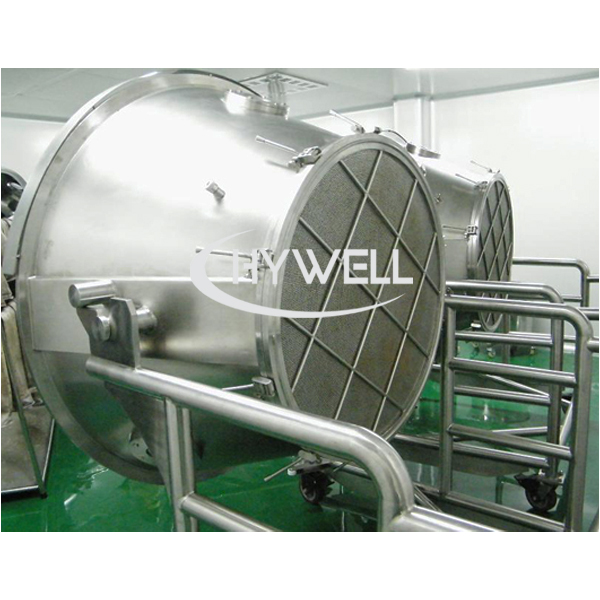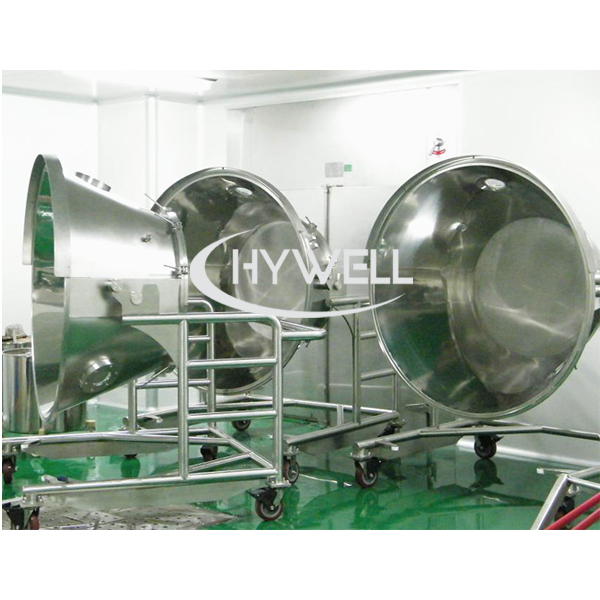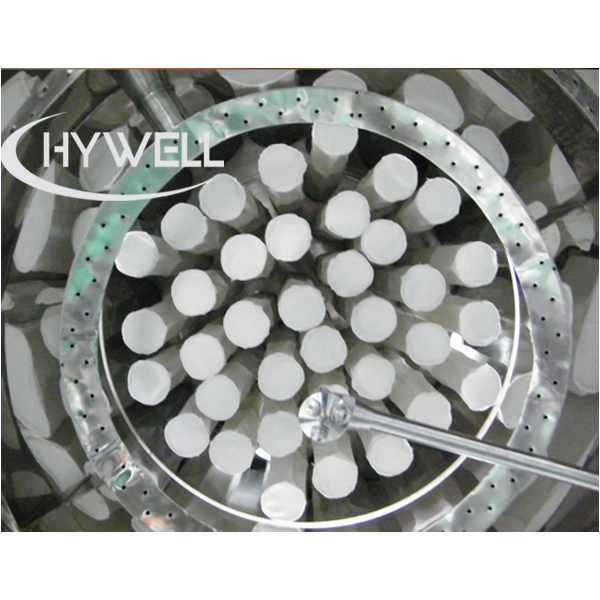With the rapid development of the modern pharmaceutical industry, continuous optimization of production technology has become a key indicator of a pharmaceutical company's competitiveness. As an advanced piece of equipment that integrates mixing, granulation, drying, and even coating, the fluidized bed granulator is widely favored for its ease of operation and high degree of process integration. Particularly in the processing of powder materials for traditional Chinese medicine preparations, chemical drugs, and food industries, fluidized bed granulation equipment has become indispensable. This article explores the basic principles of fluidized beds, systematically reviews the current application status and development trends of fluidized bed granulation technology, and helps professionals better understand its potential and challenges. Hywell Machinery, as a manufacturer of fluid bed granulators, has extensive testing and manufacturing experience and is equipped with testing machines.
1. Basic Principles of Fluidized Beds
A fluidized bed uses gas to suspend solid particles into a fluid-like state to enable efficient heat and mass transfer. The working mechanism is based on fluidization: when dry gas enters from the bottom and passes through a distribution plate, it lifts the particles into suspension. When gas velocity reaches a critical threshold, particles enter a fluidized state, moving and mixing like a fluid, thus enabling uniform heating, mixing, granulation, and other processes.
1.1 Fixed Bed Stage
The airflow is not strong enough to lift the material; particles remain static on the distributor plate, and only limited surface heating occurs.
1.2 Fluidized Bed Stage
As the airflow increases to a critical point, the particles are lifted and suspended evenly, allowing effective mixing and heat exchange.
1.3 Pneumatic Transport Stage
When airflow exceeds the settling velocity of the particles, they are carried out of the system—this is useful for material conveying or separation.

Fluidized Bed Granulation

Fluid Bed Granulation

Fluidized Bed Granulator
2. Technical Principles of Fluidized Bed Granulation
The core of fluidized bed granulation lies in using an atomized nozzle to evenly spray binder solution onto suspended powder particles. Through the wetting and bridging action of the droplets, particles gradually agglomerate, forming nuclei and eventually growing into uniform granules.
2.1 Wetting and Nucleation
The atomized droplets wet the powder surface and form initial particle nuclei.
2.2 Binding and Growth
The nuclei bind with surrounding particles through liquid bridges, increasing in size.
2.3 Drying and Shaping
The hot air evaporates moisture from the granules, resulting in solid particles with defined strength and size.
This technique allows for the production of both porous and dense spherical granules, depending on process parameters such as spray rate, inlet air temperature, and airflow velocity—offering high controllability and adaptability.
3. Key Points in Fluidized Bed Drying
Drying is a crucial step in the granulation process, directly affecting particle quality and production efficiency. The drying process generally follows three stages:
3.1 Heating Phase
Material temperature rises from ambient to the wet-bulb temperature of the hot air.
3.2 Constant Drying Phase
Surface moisture evaporates rapidly; temperature remains stable while water content decreases sharply.
3.3 Falling Rate Phase
Internal moisture migrates to the surface; evaporation slows, and temperature rises again as drying completes.
Air temperature and flow control are critical: if the temperature is too high, surface drying occurs too quickly, trapping internal moisture. If too low, drying is prolonged, reducing efficiency.
4. Development of Modern Hybrid Granulation Technologies
4.1 Agglomeration Granulation
This is one of the most common modes of fluid bed granulation. In a fluidized state, powder comes into contact with atomized binder solution, forming agglomerates. By adjusting parameters such as spray rate, binder concentration, and airflow distribution, a wide range of granule types—from lightweight and irregular to dense and spherical—can be obtained.
4.2 Coating Granulation
The powder serves as the core particle, which is coated layer-by-layer via repeated spraying and powder adhesion. This method is widely used in sustained- and controlled-release formulations, enabling multi-layered drug structures and improved stability.
5. Applications and Advantages of Fluidized Bed Granulators
5.1 Applications
Thanks to its integrated operation, fluidized bed granulators are used in:
• Pharmaceuticals: granulation of traditional and western medicine, sustained-release tablets, effervescent tablets.
• Food industry: instant powders like milk powder, juice powder, protein powder.
• Chemical industry: catalyst carriers, detergents, pesticide granules.
5.2 Equipment Advantages
5.2.1 High Process Integration
Mixing, granulating, drying, and coating all occur in one machine, reducing process steps.
5.2.2 Labor and Space Efficiency
Enclosed design lowers complexity and reduces labor intensity.
5.2.3 Controllable Granule Size
Adjustable parameters allow tailoring of granule size for different needs.
5.2.4 Improved Product Quality
Produces uniform, free-flowing particles suitable for downstream compression and filling.
6. Development Trends and Technological Advancements
6.1 Intelligent Automation
Modern fluidized bed granulators feature real-time monitoring and automatic control of temperature, humidity, and airflow—enhancing process stability and product consistency.
6.2 Structural Optimization
Trends include modular design, multifunction integration, interchangeable spray modules, multistage drying zones, and rotating fluidized beds—all improving flexibility and cleanability.
6.3 Eco-Friendly Solutions
To meet green manufacturing requirements, manufacturers are optimizing airflow and filtration systems to reduce energy consumption, recover heat, and minimize dust emissions.
6.4 Rise of Domestic Equipment
Historically dependent on imports, the fluidized bed granulator market is seeing strong development from domestic brands (e.g., Hywell Machinery). These companies have made breakthroughs in design and manufacturing, narrowing the gap with international brands and offering cost-effective, high-performance solutions—driving the modernization of Chinese medicine and domestic substitution.
7. Conclusion
Fluidized bed granulation technology, as a critical powder processing method in the pharmaceutical industry, effectively overcomes limitations of traditional wet granulation. Its advantages—high efficiency, ease of control, and integrated design—make it increasingly important across various industries. As industry standards rise and intelligent manufacturing advances, fluidized bed granulators will continue to evolve toward high-end, smart, and eco-friendly solutions—becoming a driving force for modern pharmaceutical production.
English
Русский
العربية
Français
Español
Português
Deutsch
italiano
日本語
한국어
Nederlands
Tiếng Việt
ไทย
Polski
Türkçe
ພາສາລາວ
Bahasa Melayu
Filipino
Bahasa Indonesia
magyar
Română
Čeština
қазақ
Српски
हिन्दी
فارسی
Slovenčina
Slovenščina
Norsk
Svenska
українська
Ελληνικά
Suomi
Հայերեն
עברית
Dansk
اردو
বাংলা
Hrvatski
Afrikaans
Gaeilge
Eesti keel
Māori
नेपाली
Oʻzbekcha
latviešu
Azərbaycan dili
Беларуская мова
Български
ქართული
Kurdî
Кыргызча

 简体中文
简体中文






